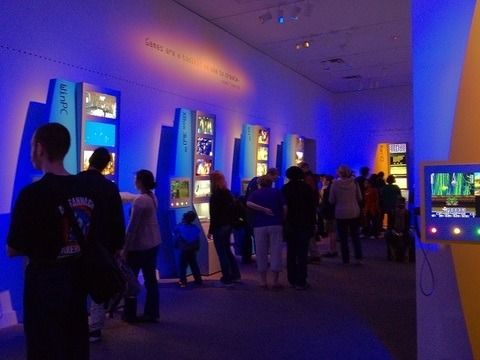The Smithsonian is a world-renowned institution, and being included in its exhibits and collections means being acknowledged as an important part of the American story. And in recent years, they have been including video games.
The History of Video Games
While visiting the Smithsonian’s National Museum of American History - which is still gradually undergoing renovations - this past weekend, I stumbled upon an important piece of video game history.
Ralph Baer’s home workshop. The “brown box” prototype is visible on the left, and the box for the finished Magnavox Odyssey is on the bottom right.
Situated prominently near the entrance to the west wing of the first floor (the “Innovation, Creativity, and Enterprise” wing) was the home workshop of the late Ralph Baer, inventor of the first video game console.
Included with the workshop was Baer’s “Brown Box,” his late-1960’s prototype for what later became the Magnavox Odyssey. A screen above the prototype shows video footage of gameplay from Baer’s Table Tennis game, which was the inspiration for the legendary Pong.
The “Brown Box” video game console prototype
Baer first donated his prototypes, along with notes, schematics, and other papers, to the museum back in 2006; he agreed to part with his workshop later, a few months before his death in 2014. It went on display as the wing’s “landmark object” in July 2015, not only because of its importance to video game history, but also because they felt it “symbolized the workshops or workbenches of thousands of American tinkerers and inventors.”
The Art of Video Games
But acquiring Baer’s workshop and prototypes isn’t the only way the Smithsonian has begun to embrace video games. For six months in 2012, the institution’s American Art Museum put on a major exhibition celebrating video games as an artistic medium, called “The Art of Video Games.”
Visitors to the exhibit on opening weekend
The stated purpose of “The Art of Video Games” was to “explore the 40 years of evolution of video game as an artistic medium. The focus was on visual effects, the usage of new creative technologies and the most influential artists and designers.” So it did focus on a more traditionally “artistic” aspect of video games, rather than one of the more unique elements of the medium such as gameplay, but it’s still an important acknowledgement of the artistic value of video games.
Following the exhibition’s presentation in Washington, D.C. (it has since gone on tour around the country and will next appear in Miami, FL), the American Art Museum has added two games to its permanent collection: Flower and Halo 2600. Additionally, they now host the annual Indie Arcade in the museum’s enclosed courtyard. They also held a panel in 2012 on video game preservation.
What’s the big deal?
These may sound like small steps - more like “grudgingly accepting” than “embracing” - that aren’t on par with things like the museums dedicated to video games popping up around the world, such as the Computerspielemuseum in Berlin, the Videogame History Museum, and The Strong National Museum of Play’s extensive gaming collection. And certainly, more could be done. For example, it would be wonderful if the American Art Museum could acquire more games and allow visitors to play them, the way the Museum of Modern Art does, but the AAM is likely limited by funding and space.
But even the small steps are important. The Smithsonian museums are considered America’s “national” museums. While being included (and preserved) in any museum is nothing to sneeze at, being included in the Smithsonian is a major validation of video games’ importance to American culture.
Hopefully, they will continue to add more games and artifacts to their collections and exhibitions. And if other major institutions follow suit, video games may finally get the respect they deserve.



